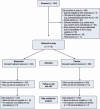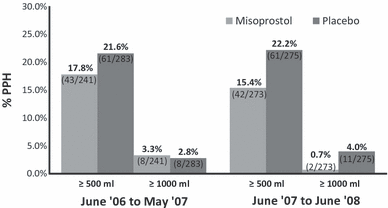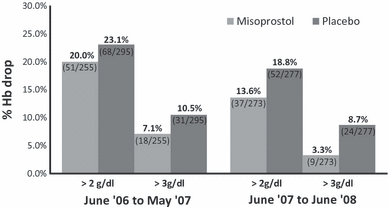Administration of misoprostol by trained traditional birth attendants to prevent postpartum haemorrhage in homebirths in Pakistan: a randomised placebo-controlled trial
- PMID: 21176086
- PMCID: PMC3041931
- DOI: 10.1111/j.1471-0528.2010.02807.x
Administration of misoprostol by trained traditional birth attendants to prevent postpartum haemorrhage in homebirths in Pakistan: a randomised placebo-controlled trial
Abstract
Objective: to determine if misoprostol is safe and efficacious in preventing postpartum haemorrhage (PPH) when administered by trained traditional birth attendants (TBA) at home deliveries.
Design: a randomised, double-blind, placebo-controlled trial.
Setting: Chitral, Khyber Pakhtunkhwa Province, Pakistan.
Population: a total of 1119 women giving birth at home.
Methods: from June 2006 to June 2008, consenting women were randomised to receive 600 microg oral misoprostol (n = 534) or placebo (n = 585) after delivery to determine whether misoprostol reduced the incidence of PPH (≥ 500 ml).
Main outcome measures: the primary outcomes were measured blood loss ≥ 500 ml after delivery and drop in haemoglobin >2 g/dl from before to after delivery.
Results: oral misoprostol was associated with a significant reduction in the rate of PPH (≥ 500 ml) (16.5 versus 21.9%; relative risk 0.76, 95% CI 0.59-0.97). There were no measurable differences between study groups for drop in haemoglobin >2 g/dl (relative risk 0.79, 95% CI 0.62-1.02); but significantly fewer women receiving misoprostol had a drop in haemoglobin >3 g/dl, compared with placebo (5.1 versus 9.6%; relative risk 0.53, 95% CI 0.34-0.83). Shivering and chills were significantly more common with misoprostol. There were no maternal deaths among participants.
Conclusions: postpartum administration of 600 microg oral misoprostol by trained TBAs at home deliveries reduces the rate of PPH by 24%. Given its ease of use and low cost, misoprostol could reduce the burden of PPH in community settings where universal oxytocin prophylaxis is not feasible. Continual training and skill-building for TBAs, along with monitoring and evaluation of programme effectiveness, should accompany any widespread introduction of this drug.
Figures



Comment in
-
Oral misoprostol reduces the risk of postpartum haemorrhage in home births assisted by trained traditional birth attendants in Pakistan.Evid Based Med. 2011 Dec;16(6):180-1. doi: 10.1136/ebm1403. Epub 2011 May 8. Evid Based Med. 2011. PMID: 21555320 No abstract available.
-
Administration of misoprostol by trained traditional birth attendants to prevent postpartum haemorrhage in home births in Pakistan: randomised placebo-controlled trial.BJOG. 2011 Jul;118(8):1018; author reply 1018-9. doi: 10.1111/j.1471-0528.2011.03015.x. BJOG. 2011. PMID: 21658197 No abstract available.
-
Misoprostol in the management of postpartum haemorrhage in low-resource settings.BJOG. 2011 Aug;118(9):1144; author reply 1144-5. doi: 10.1111/j.1471-0528.2011.02986.x. BJOG. 2011. PMID: 21749617 No abstract available.
References
-
- Khan KS, Wojdyla D, Say L, Gülmezoglu AM, Van Look PFA. WHO analysis of causes of maternal death: a systematic review. Lancet. 2006;367:1066–74. - PubMed
-
- Ramanathan G, Arulkumaran S. Postpartum haemorrhage. J Obstet Gynaecol Can. 2006;28:967–73. - PubMed
-
- AbouZahr C. Global burden of maternal death and disability. Br Med Bull. 2003;67:1–11. - PubMed
-
- United Nations. The millennium development goals report 2009 [Online] 2009. [ http://www.un.org/millenniumgoals/pdf/MDG%20Report%202009%20ENG.pdf]. Last accessed 26 July 2009.
-
- National Institute of Population Studies (NIPS) [Pakistan], Macro International Inc. Pakistan Demographic and Health Survey 2006–07. Islamabad, Pakistan: National Institute of Population Studies and Macro International Inc.; 2008.
Publication types
MeSH terms
Substances
LinkOut - more resources
Full Text Sources

